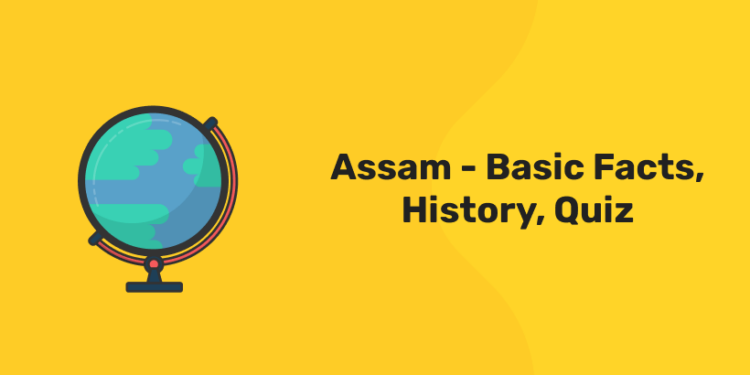Table of Contents
Assam is the largest north-eastern state in terms of people and second in terms of land, and it is located in India’s north-east. Assam has a total size of 78,438 square kilometres (30,285 sq miles). The state is bordered on the north by Bhutan and Arunachal Pradesh; on the east by Nagaland, Arunachal Pradesh, and Manipur; on the south by Meghalaya, Tripura, Mizoram, and Bangladesh; and on the west by West Bengal. Assam is unique in that it encompasses three of India’s six physiographic divisions: the Northern Himalayas (Eastern Hills), Northern Plains (Brahmaputra Plain), and Deccan Plateau (Karbi Anglong).
Download Entri App – Learn about a variety of fascinating topics .
Assam: History
Assam has a long and illustrious history, which may be traced back to Vedic and Tantric literature, Assamese folklore, and Buddhist literature. In the state, people of Indo-Aryan, Austro-Asian, and Tibeto-Burman ancestry have coexisted, resulting in the current blend of culture and tradition. Several attempts have been made by historians to reconstruct the prototype of Assam’s history using manuscripts and mediaeval materials found in various parts of the state.
The mythological origins of the Indian state of Assam are thought to be the source of its history and beginnings. Apart from two mediaeval works, the Kalika Purana and the Yogini Tantra, the earliest reference of the area may be found in epics like the Mahabharata and other holy traditions. The region’s first people are said to have lived in the Rongram valley of the Garo Hills during the Middle Pleistocene period, some 126,000 years ago.
During the time of the epics, Assam was known as Pragjyotishpur or Kamrupa. The formation of the Varman Dynasty of Pushya Varman in the early fourth century marks the start of the state’s history. This dynasty is supposed to have originated in Australia and has ties to Narakasura. This was followed by the Salasthamba Mlechchha Dynasty, which lasted until the late ninth century. Following this, Brahmapala, a new ruler, was elected, resulting in the formation of a new dynasty known as the Pala Dynasty. The kingdom of Kamrup came to an end in the 12th century A.D. due to the fall of subsequent rulers and dynasties.
In mediaeval Assam, kingdoms such as the Khen Dynasty, Koch Dynasty, and Kachari and Chutiya Kingdoms rose and fell. During this time, a major kingdom known as the Ahom Kingdom arose, revolutionising the state’s whole cultural and traditional landscape. The state was invaded by the Burmese near the conclusion of this era, and they were defeated in the early nineteenth century. Finally, after the signing of the Treaty of Yandaboo, the British took possession of Assam, marking the beginning of British authority in the state.
The British attempted to organise Assam’s administrative, transportation, and communication networks. The construction of railways, the formation of tea plantation areas, and the finding of coal and oil are just a few of the key changes that occurred during colonial administration. However, Assam had territorial divisions after independence, such as the partitions of Arunachal Pradesh in 1948, Nagaland in 1963, Meghalaya in 1972, and Mizoram in 1987. Assam’s population is primarily made up of migrants from Burma and China, resulting in a blend of Mongol and Aryan culture.
Assam: Basic Facts
1: Who was the first woman President of India?
- With a population of 31.2 million people, Assam is India’s 15th most populated state.
- Languages – Assamese is the most widely spoken language in Assam, accounting for around 49% of the population. Following that, Bengali (27 percent), Hindi (6%), Bodo (5%), Nepali (2.12 percent), and other languages are spoken.
- Assam has a long history; in ancient times, it was known as Pragjyotishpur (Ja Pragjyotich).
- Religion – Hinduism accounts for 61 percent of Assam’s population, with Muslims accounting for 35 percent, Christians for 4%, Buddhists for 4%, and Jains for 4%. You might be astonished to learn that the Hindu population in Assam was 64 percent in 2001, but the ratio has reduced as a result of Muslim intruders arriving from Bangladesh on a regular basis. Muslims constitute the majority in ten Assam districts.
- The western section of Assam was part of the Mauryan Empire during the Maurya period, which was most likely won by Chandra Gupta Maurya.
- Assam was a vast state with Shillong as its capital after independence. Nagaland was separated from Assam in 1968, followed by Meghalaya and Mizoram in 1972, on the basis of cultural demands. After Shillong, the state capital, was relocated to Meghalaya, Assam’s capital was renamed Dispur.
- Assam’s lifeline is said to be the Brahmaputra River. The Brahmaputra river valley is around 100 kilometres broad and 1000 kilometres long, and it runs through the heart of the state.
- With a land area of 78,438 square kilometres, Assam is India’s 17th largest state, bordering all of the northeastern states as well as Bhutan, Bangladesh, and Myanmar.
- The Brahmaputra River’s Majuli Island in Assam is the world’s largest river-built island.
- Assam is home to the most wild buffalo in India. Aside from it, the majority of bird species are also in this state. Assam is home to over 820 bird species and 190 animal species.
- Bihu is the focal point of Assamese culture: Bihu is an Assamese state festival that takes place three times a year.
- Assam’s silk is famous all over the globe: Gondi Silk, Golden Muga, Pat, and warm eri are all world famous.
Free UPSKILLING Courses!
Take your first step toward mastering in-demand skills, acing interviews, and securing top-tier jobs with Entri's free upskilling courses.
Start Learning!Assam: Quiz
Q.1. Who is Assam’s current Chief Minister?
A.Prafulla Kumar Mahanta
B.Tarun Gogoi
C.Himanta Biswa Sarma
D.None of These
Answer: C.Himanta Biswa Sarma
Q.2. With context to a culture of Assam, what is ‘Jaapi’?
A.Folk dance of Assam
B.Conical hat made from bamboo
C.Tribe of Assam
D.Silk knitted fabrics
Answer: B.Conical hat made from bamboo
Q.3. What is the state bird of Assam?
A.White-winged duck
B.Asian koel
C.Western Tragopan
D.Black francolin
Answer: A.White-winged duck
Q.4. Which country is to the west of Assam?
A.Spain
B.Bangladesh
C.Bhutan
D.None of These
Answer: B. Bangladesh
Q.5. The first conference of Asam Sahitya Sabha was held at
A.Kamrup
B.Sivasagar
C.Barpeta
D.Dhuburi
Answer: B.Sivasagar
Q.6. Which of the following is the state flower of Assam?
A.Rose
B.Lily
C.Foxtail Orchids
D.Dahlia
Answer: C.Foxtail Orchids
Q.7. When did the British annex Assam?
A.1926
B.1726
C.1826
D.None of These
Answer: C.1826
Q.8. Who was the First CM of Assam?
A.Gopinath Bordoloi
B.Bishnu Ram Medhi
C.Bimala Prasad Chaliha
D.Mahendra Mohan Choudhry
Answer: A. Gopinath Bordoloi
Q.9. Which one is the largest district by area in Assam?
A.Diphu
B.Barpeta
C.Dhemaji
D.None of These
Answer: A. Diphu
Q 10. Which of the following is the state tree of Assam?
A.Hollong
B.Neem
C.Sal
D.Coconut
Answer: A. Hollong













